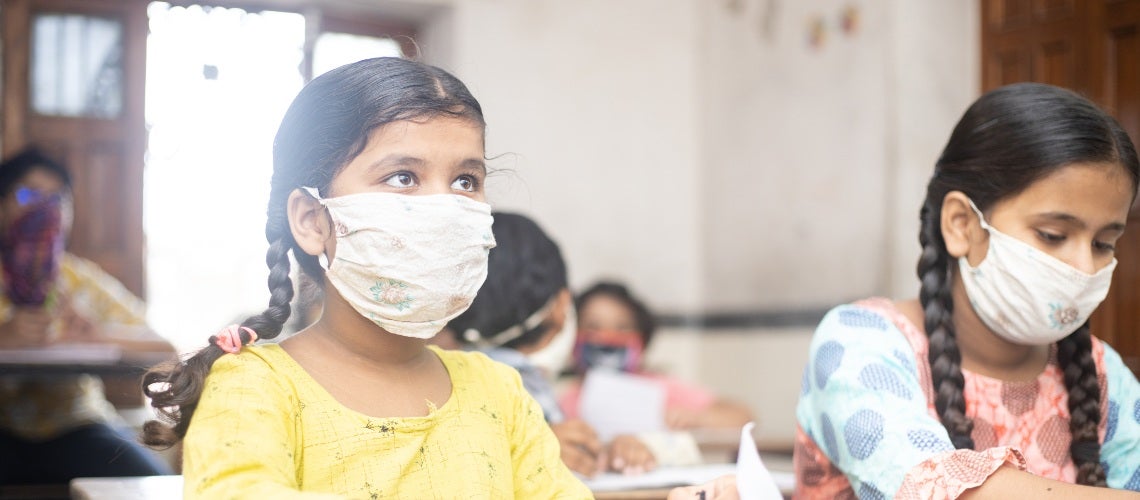 The COVID-19 pandemic reversed a steady upward trend in per capita real public spending on education. Copyright: Shutterstock
The COVID-19 pandemic reversed a steady upward trend in per capita real public spending on education. Copyright: Shutterstock
Even before COVID-19, the world was facing a learning crisis, with nearly 6 out of every 10 ten-year-olds in low- and middle-income countries (LICs and MICs) suffering from learning poverty—meaning they were unable to read and understand a simple story. Now COVID-19-related school closures and disruptions have deepened the crisis, sharply increasing learning poverty and exacerbating the inequalities in education.
Without urgent action to reduce learning poverty, we face a learning and human capital catastrophe. If children do not acquire the basics of literacy—together with numeracy and other foundational skills—the futures of hundreds of millions of children around the world, and their societies, are at grave risk. There is a narrow window to act decisively to recover and accelerate learning. This will require firm political commitment and implementation of evidence-based approaches for rapid impact. Combating learning poverty and the deepened learning crisis will also require additional financial resources.
The spending gap between the richest and poorest countries is enormous - and getting wider
The recently released Education Finance Watch 2022 presents stark findings on the gap in education spending between the richest and poorest countries and on the heavy burden carried by households on education costs. Government education spending, as a percentage of gross domestic product (GDP), has remained largely unchanged in all country income groups since 2010 – except for LICs. Across the 10-year period, the share of government education spending of GDP has fluctuated marginally between 4.7 percent and 4.9 percent for middle- and high-income countries, and the global percentage in 2020 is on par with 2010. Government education spending in LICs has been on a moderate upward trend since 2010, reaching an average of 3.6 percent in 2020, still below international benchmarks.
The COVID-19 pandemic reversed a steady upward trend in per capita real public spending on education. One-third of lower-middle-income countries (LMICs) and half of upper-middle-income countries (UMICs) spent less per capita on education in 2019-2020 than they did in 2014-2015. In 2020, the first year of the COVID-19 pandemic, 40 percent of LICs and LMICs reduced their spending on education with an average decline in spending of 13.5 percent. In Latin America and the Caribbean, per capita government spending on education fell below its mid-2010s levels.
In 2020, government per capita spending was $53 in LICs, $1,079 in UMICs, and $7,787 in high-income countries (HICs). Interestingly, there is divergence between 2019 and 2020 between HICs, where spending increased, and UMICs, where spending decreased. In 2020, average government per capita spending in sub-Saharan Africa ($254) and South Asia ($358) was less than one-tenth of average per capita spending in Europe and Central Asia ($6,156). This massive spending gap continues to underpin, drive, and exacerbate global inequality.
Note: Estimates on spending as percentage of GDP include interpolated values. Interpolation was done to fill missing data and ensure comparable sample of countries in all periods.
Households in LICs and LMICs continue to bear a significant portion of education costs, through out-of-pocket expenditures, accounting for 39 percent of the total spending in education compared to 16 percent in HICs. Within countries, the richest spend far more on education, further entrenching inequality: in 33 LICs and MICs, households from the richest quintile spent 4.2 percent of their budget on education compared to just 2.4 percent among households in the poorest quintile.
Governments account for less than half of total spending in low-income countries
Distribution of total education spending by source, year, and country income level group, percentage, 2010-2020
Note: Interpolation was done to fill missing data and ensure comparable sample of countries in all periods
Has aid come to the aid?
Total aid to education reached a record high of $18.1 billion in 2020. However, the increase was largely driven by direct budget support to countries to help manage the impacts of the pandemic. In 2020, the World Bank alone increased education support to sub-Saharan Africa by 25 percent.
Aid to education increased by 15 percent in 2020
Aid to education, by level, 2019-2020
Aid to education from bilateral donors fell by $359 million in 2020. The decrease was concentrated among four donors (Saudi Arabia, Turkey, United Kingdom, and United States), who collectively decreased their education aid by $747 million. France, Germany, and Japan increased their education aid by US$597 million. The overall decline in direct bilateral aid to education is worrisome considering the potential effects of several ongoing crises, which may have longer-term impacts on aid to education.
Education aid lost ground to other sectors in 2020. Official development assistance for education has been constantly below other sectors over the past 10 years. Education’s share of total aid has declined from 11.7 percent in 2010 to 9.7 percent in 2020, which is approximately half of the allocation to health, which often ranges between 18 to 20 percent. Health saw an unsurprisingly stark COVID-19 increase in 2020.
Education, government, and health as a share of total sector-allocable aid (disbursements), 2010–2020
Closing the education resource gap must start now
There is a crisis in education financing, which has deepened with COVID-19. Urgent action is needed by governments and development partners to deliver on existing education goals and prepare for the future. In preparation for the United Nations Transforming Education Summit (TES) in September 2022, the Thematic Action Track 5: Financing of education, has laid out three priority actions:
- Mobilize more resources;
- Increase equity and efficiency of spending on education; and
- Provide systematic and reliable education financing data and deepen accountability.
Put together, these actions form the basis of a new global compact on education financing, linking new domestic commitments with new international action on issues affecting education financing – to increase the share, size, sensitivity, and scrutiny of education budgets. The work to close the education resource gap must start now, if we are to stand a chance of rebuilding and reshaping the future of a generation of children.






Join the Conversation